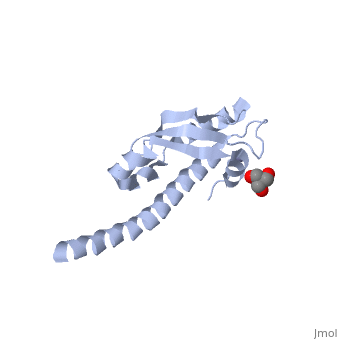TolA
From Proteopedia
| |||||||||||
3D structures of TolA
Updated on 27-February-2020
1lr0 – TolA domain III – Pseudomonas aeruginosa
1s62 – EcTolA C terminal – Escherichia coli – NMR
2x9a - EcTolA C terminal + attachment protein G3P
1tol - EcTolA C terminal/minor coat protein
3qdr - EcTolA domain III + colicin A residues 53-107
3qdp - EcTolA domain III
6fw4 – VcTolA C terminal – Vibrio cholerae - NMR
4g7x – VcTolA C terminal + uncharacterized protein
References
- ↑ 1.0 1.1 Lazzaroni JC, Vianney A, Popot JL, Benedetti H, Samatey F, Lazdunski C, Portalier R, Geli V. Transmembrane alpha-helix interactions are required for the functional assembly of the Escherichia coli Tol complex. J Mol Biol. 1995 Feb 10;246(1):1-7. PMID:7853390 doi:http://dx.doi.org/10.1006/jmbi.1994.0058
- ↑ 2.0 2.1 Levengood-Freyermuth SK, Click EM, Webster RE. Role of the carboxyl-terminal domain of TolA in protein import and integrity of the outer membrane. J Bacteriol. 1993 Jan;175(1):222-8. PMID:8416897
- ↑ 3.0 3.1 3.2 Deprez C, Lloubes R, Gavioli M, Marion D, Guerlesquin F, Blanchard L. Solution structure of the E.coli TolA C-terminal domain reveals conformational changes upon binding to the phage g3p N-terminal domain. J Mol Biol. 2005 Mar 4;346(4):1047-57. Epub 2005 Jan 12. PMID:15701516 doi:10.1016/j.jmb.2004.12.028
- ↑ Witty M, Sanz C, Shah A, Grossmann JG, Mizuguchi K, Perham RN, Luisi B. Structure of the periplasmic domain of Pseudomonas aeruginosa TolA: evidence for an evolutionary relationship with the TonB transporter protein. EMBO J. 2002 Aug 15;21(16):4207-18. PMID:12169623
- ↑ 5.0 5.1 Schendel SL, Click EM, Webster RE, Cramer WA. The TolA protein interacts with colicin E1 differently than with other group A colicins. J Bacteriol. 1997 Jun;179(11):3683-90. PMID:9171417

